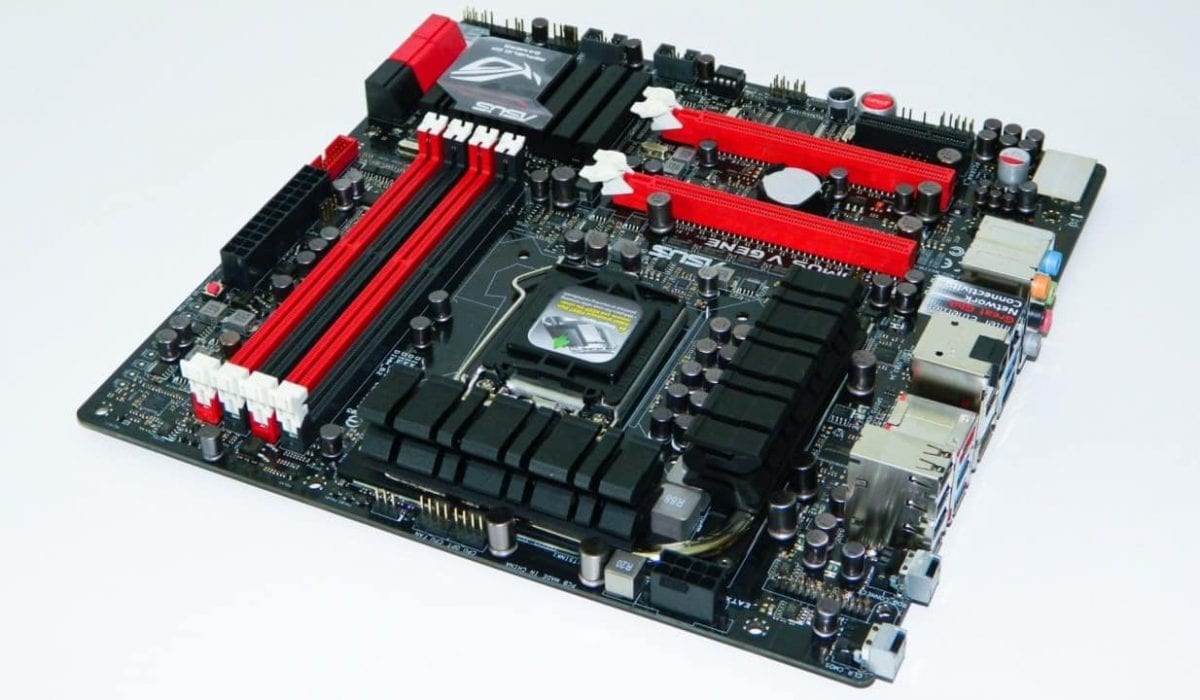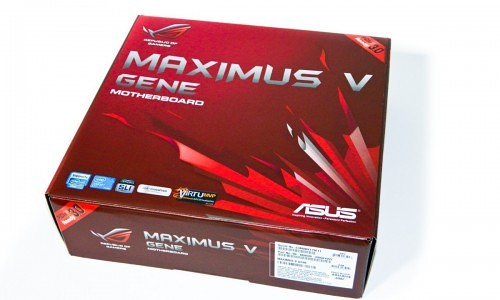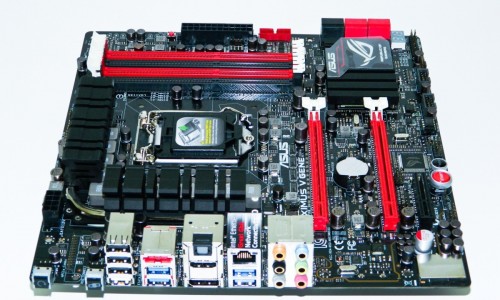With the advancements in computer technology, it is now possible to build a high performance computer using any motherboard form factor from mini ITX all the way up to XL-ATX. The question is, why would anyone want to build a such a compact system with its inherent expansion limitations? The answer is not just one. For example, have you ever dragged a full sized computer system in to your favorite LAN, or simply wanted something with a manageable foot print to connect to home theatre? A smaller form factor is a benefit in both scenarios and the micro ATX or mATX form factor gives us the best mix of size and expansion.
The ASUS Maximus V Gene motherboard may be a micro ATX board in form factor, but is anything but micro. We found that there’s plenty more inside the crimson red box than meets they eye in our latest review.
ROG Maximus V GENE – Features and Specifications
ASUS’ Republic of Gamers (ROG) Z77 series of boards comes in three flavors: the Extreme designed for maximum expansion, performance as well as the most extreme overclocking, the Formula best suited for an all round premium gaming experience, Formula-SupremeFX which couples a 300 ohm amplified external audio codec for exemplary audio, and the Gene designed to offer a LAN party size solution of the Formula by scaling back on some of the redundant, unneeded expansion except for NVIDIA SLI/AMD CrossFireX support.
The GENE offers features unique to it and the other ROG channel marketed P8Z77 boards. Let’s cover the big ones:
- SupremeFX III is a cost effective, yet hardware specific audio codec designed to physically produce greater quality sound through THX TruSudio Pro, Sound Blaster, X-Fi MB2, or EAX HD 5.0 output. Audio quality is ensured thanks to a completely separate component implementation to cut out electrical noise. Nichicon capacitors as well as a 1500uF capacitor ensure strong continuous audio without cutting out at those pivotal action moments.
- GameFirst and Intel Gigabit LAN both work hand in hand with IGL requiring low resources and better sustained bandwidth while GameFirst truly prioritizes your game network traffic without sacrificing bandwidth and connectivity quality for things like streaming audio or video, while maintaining low network latency for games.
- ROG Connect lets you monitor your system through a USB cable (white USB port) using another PC or a notebook, similar to how tuners monitor the performance of their vehicles. Extreme overclockers can manipulate and monitor the any ROG board so you know which settings may award the next world record. Or you can simply use it to monitor the system and catch that elusive Windows glitch from a puzzling performance setting.
- CPU Level Up lets you use your ROG board to instantly overclock your CPU to the next model processor up. Pick the CPU in the list and let the motherboard do the rest. Then use the ROG CPU-Z to show off your overclock.
- Extreme Engine DIGI+ II is similar to any DIGI+ II design except engineers use extra 10K Black Metallic capacitors to support the digital VRM for better power distribution and consistently higher frequency output.
- ROG USB Flashback recovers your BIOS without actually being powered on. You don’t even need major components installed. Just connect your power and USB flash drive with the proper BIOS. The board will do the rest.
- LucidLogix MVP, an Intel Z77 Chipset staple, lets ROG fans utilize their Intel Ivy Bridge integrated graphics to help increase frame rates along with their discreet GPU. Install the MVP drivers, enable MVP, and gain some extra frames to smooth out your game play.
- Daemon Tools Pro Standard is a gamer friendly program that lets you turn optical media (like all your game DVDs) in to virtual copies that emulate the real discs, allowing you to preserve your physical media, or save room at your next LAN event.
- Why do you need Kaspersky Anti-Virus? Everyone knows gamers are an adventurous bunch. And, you never know what kind of virus infects anyone of the machines at big LAN parties. Protect your machine and others from the guy who doesn’t protect his! ASUS includes a copy of this in the box.
ASUS naturally bundles AI Suite II which is still the most comprehensive software offered by any motherboard manufacturer. It includes tools for system monitoring, power management, overclocking, Ai Charger+ (USB charging), USB 3.0 Boost for enhanced USB throughput, Disk Unlocker, and Fan Expert 2 which is built in to the AI Suite II package. The great thing about all this software is that it works well and has a purpose all located in one place rather than through several random programs.
ASUS ROG Maximus V GENE Up Close
Naturally, the ROG red and black theme help identify this board. You won’t mistake the GENE or any other ROG board for another brand. Black anodized heat sinks with a heat pipe cool the vital power components around the CPU socket. Black Nichicon solid state capacitors can be seen everywhere.
All of the key SATA, power connectors, SATA III, USB 3.0, and fan headers are all located on the outer edge of the PCB save for one fan header above the top PCIe slot. Even the big red power and black reset buttons as well as the MemOK! buttons are sensibly located. The back IO ports are all color coded for easy interpretation.
The bottom left corner of the board has a peculiar orange outline that runs along between traces. Everything on the outside edge is part of the audio circuitry. The very corner houses the full featured Realtek audio processor. This is called “audio moat” and like the moat around a castle, it keeps things you don’t want in, out. In this case, that’s all the electrical noise that comes from the other components on the board. This is quite ingenious and is far more advanced than other solutions we’ve come across that simply use a piece of metal or a cover, to block the noise out.
What Comes with Your ROG Maximus V GENE?
ASUS doesn’t skimp when it comes to ROG bundles. Inside is your all important “Do Not Disturb” door tag, white ROG Connect cable, six black 90-degree SATA cables, SLI/CFX PCIE bridge, mPCIe combo card, SATA cable labeling stickers, front case-panel Quick Connectors, black IO case shield, highly detailed manuals, and drivers/software disc. That extra mini-PCIe combo card has two empty slots. Add some secretive extra storage and/or a mini-WiFi card if you’d like.
BIOS and Overclocking
Not all BIOS are created equally, which has been very evident in the latest transition to GUI based interfaces. While the P8Z77 series utilizes a BIOS we found to be the best of all channel boards, the ROG series including the GENE have very strong BIOS code pumping through its veins. As with all Ivy Bridge overclocking, your CPU attributes will vary. While few can reach the 2800MHz DDR3 maximum, a higher overclock may be possible with the right components. Keep this in mind.
It pains me to admit, the GENE in the lab is far more potent than our Core i7-3770K. I fear the TIM (thermal interface material) underneath has shifted as heat is more of an issue now. With the right water cooling block, the GENE easily maintains the three overclock presets. The maximum overclock of the chip is 4.8 to 4.85GHz. The IMC was probably the first part to suffer as it can’t maintain 2800MHz DDR3 stability. However, the GENE keeps it in the 2600-2666MHz range.
However, my Core i7-2600K Sandy Bridge processor is a gem. The GENE made sure it hit 5.3GHz by using the tried and true Offset voltage option instead of manually applying voltage to the core. This setting only uses the necessary voltage as needed and not forcing a full 1.44 volts at all times.
Test System Configuration
All the components are the same used in our “INTEL Z77 Motherboard Round Up” a few months back. Even though the ROG Maximus V GENE is from the Z77 species, it is a different breed. My objective is to see if there are any benefits to being of the ROG kind.
Here’s the break down of the test configuration:
- Processor: Intel Core i7-3770K Ivy bridge
- Motherboard: ASUS ROG Maximus V GENE
- Memory: Kingston HyperX 2800MHz DDR3
- Graphics: MSI GTX 560 Ti Twin Frozr II SLI
- Storage: Kingston HyperX 120GB SSD
- Power: Antec TPQ-1200
- Cooling: NZXT HAVIK 140 (Water cooling for OC tests)
- OS: Windows 7 Pro 64-bit
All the latest drivers, utilities, and BIOS were installed or used in testing. Screen resolution was 1920 x 1080 since this is a gamer optimized platform and this is the preferred HD resolution for gaming today. I did not have any performance level mSATA or mini-PCIE devices to test the empty module thoroughly so this will be left out of this particular review.
One potential issue did arise when installing the CPU cooler in the traditional orientation. The top PCIe slot is so close that it can make contact with a large CPU cooler longer than 5.375 inches (136.53 mm). The HAVIK 140 is a little too close for comfort so it may be necessary to turn your cooler sideways. If your enclosure has good air flow, it won’t hurt anything.
CPU Benchmarks
I started off comparing the board’s overall performance against the other Z77 boards in the lab. The benchmarks test things like BIOS to CPU tuning as well as many of the subsystems like memory.
Single core performance is on par with the rest. However, Cinebench shows us how the ROG tuning benefits the processor. The score was consistent as well after repeated tests. Let’s check out another benchmark that ROG tuning can influence.
Again, the slightly more aggressive GENE bests its bigger ATX brothers proving that the size or number of components don’t make a system run better. This was achieved using the latest BIOS update as well.
As expected, the CPU is mainly doing all the work here. I just wanted to see if there were any extra gains. Either way, no complaints.
CPU Benchmarks Continued
The GENE’s BIOS does well managing the communication between the memory and processor. I did notice that the CPU reached turbo frequencies a bit more quickly. In this particular case, it makes all the difference. Use a GENE for video editing? Sure, why not!
Finally, the GENE again proves a well tuned engine makes a better ride. After three passes, this was the average. Often the score would increase in to the fourth and fifth test. This wasn’t the case on all the other boards which were more consistent. I think we’ve established the GENE has great CPU support.
3D Graphics
This is a major gaming platform. I could list five to ten video games but the frame rates were all very consistently close. Frame rates were often one or two more depending on the title, so I’ve listed three DirectX11 titles (Aliens vs Predator, Metro 2033, and Batman Arkham City) that require a stable system to run properly.
As you can see, the GENE platform provided an extra frame or so giving us a little better average. Is it enough to make you dump your lack luster P67 or featureless Z77 board? Let’s look at a few more things first.
I/O Benchmarks
All of GENE’s expansion and data ports were tested as the platform offers the latest ASMedia controller that features the latest UASP multiple queue depth support which none of the other manufacturers seem to be using just yet. This mainly benefits your storage needs if you’re using multiple sessions of data at once. Additionally, it also offers USB 3.0 Boost which we saw posting strong transfer rates on the P8Z77-V Deluxe and Sabertooth Z77 reviewed earlier.
The Deluxe and Sabertooth offer the fastest transfer rates using USB Boost through the chipset ports. The GENE is only slightly slower in PCH and ASMedia read tests and much slower in write using Turbo mode. I would have expected it to be nearly the same but not the end of the world without it.
Intel LAN controllers still continue to be the best cost effective integrated choice. Any other solution tends to cost quite a bit more and require its own memory and usually, extra real estate on the PCB. The only thing I have to compare to the Gamefirst app is the G1.Killer NIC manager. The difference between the two is that Gamefirst feels a little more balanced and less buggy. The Killer manager doesn’t always do what it is told.
Power Consumption
Comparing motherboard power consumption is not as easy as it seems. Every board has different BIOS settings and physical components. While the difference is minimal among like chipset series boards, it does vary among manufacturers. Most boards are set up to run optimally. Some boards are meant for efficient power consumption while others like the GENE tuned for high performance. Thus, all boards are left to their “normal” factory defaults. Keep this in mind as we weigh the data.
The system was allowed to sit idle and load for 60 minutes which is more than enough to record wattage being consumed. As you can see, the GENE doesn’t consume a lot more power when idle. Because it is a motherboard with performance BIOS tuning, it consumes only a little bit more under stock and overclocked loads. It’s not much higher at all and credits the platforms efficient components.
Audio Performance
The GENE’s audio components are separated on the PCB with the exception of the traces that carry power to the caps. This kind of implementation should be better than average performance. I took the time fine tuning the GENE’s audio settings in order to find optimal volume levels. Here are the results.
The SupremeFX III does a fine job of producing a surprising amount of volume along with clarity. If you need it loud and clear, expect to get it. The separating of components favor the board eliminating stereo cross talk (channel leaking in to each other) scoring Excellent. The only issue here is the average THD+Noise dB indicating a possible, though menial, limitation of the Realtek codec and amplifier. Can you tell when the system is in the midst of a battle? No, not at all.
Final Thoughts
What attributes make a motherboard an ROG? If it’s the higher quality components, proven digital power management, efficiency, stability, high performance, expansion needed to last, and overclocking, then the ASUS Maximus V GENE is worthy of wearing the ROG badge. It’s the best performance micro-ATX built for gaming, yet it will likely benefit particularly picky media creators as well. It also rivals most full sized ATX boards currently available even with their fancy Thunderbolt ports.
While the transistor gods assure us that all ROG are equal or better, it’s their pricing that sometimes make them an elusive choice. Prices reach $379.99 for the Extreme, $359.99 for the Formula ThunderFX, and $309.99 for the Formula. This makes the $199.99 GENE an extremely attractive all around gaming motherboard as you get all of the ROG higher performance and features without paying too much of a premium. However, if you do need more expansion slots, the ATX form factor of the Formula may be a better choice.
Focusing on the Maximus V GENE only, I feel it definitely deserves a strong recommendation and recognition for its higher than average performance characteristics. We award both our Recommended and High Performance Awards.
Pros
- Attractive ROG design
- Very good all around performance
- Innovative audio implementation
- Assembled with high quality components
- Very good overclocking performance
- ROG BIOS, Recovery, and AI Suite II
- Big motherboard bundle
Cons
- May have to change orientation of large CPU coolers
Overall Rating: 9.0 / 10.0
Help Us Improve Our Reviews By Leaving a Comment Below!



